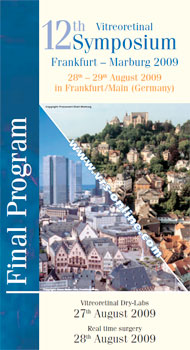12th Vitreoretinal Symposium Frankfurt – Marburg 2009
Scientific programm: Abstract
5th scientific session: The Upcoming
35. An Introduction to the NAVILAS:
A Significant Technological Advance in the
Management of Retinal Diseases
Michael D. Ober (Southfield)
Objective: To describe the Navigated Laser (NAVILAS), a new device for retinal disorders which integrates diagnostic imaging and laser functionality with real time image overlay and continuous alignment.
Purpose: To describe the functionality of a new clinical instrument with integrated diagnostic imaging and therapeutic laser for the evaluation and treatment of retinal disease.
Methods: The NAVILAS (OD-OS, Inc; Teltow, Germany) was tested in the laboratory and used to treat selected patients with proliferative diabetic retinopathy and diabetic macular edema in the clinic. 25Hz frame rate recording of treatments, follow-up examination, fundus photography and angiography were all used to analyze and evaluate the treatment process.
Results: The NAVILAS successfully produced high quality color (non-mydriatic and mydriatic), red free, infra-red and fluorescein angiographic digital images. Reviewing these images on the accompanying touch screen, areas with pathology were individually identified and marked for treatment by the treating physician using green notation. Specific zones to avoid treatment, such as the foveal avascular zone, were outlined in yellow. The fluorescein images, including added notations, were then projected as an overlay on a live fundus view and continuously aligned in real time. Thermal laser treatment in focal, grid, and pan retinal photocoagulation techniques were then delivered as pre-planned during the review stage. Several adjustable features of the NAVILAS including laser power, duration, spot size, and automated pattern laser application were also successfully evaluated.
Conclusion: The NAVILAS represents a significant advance in the diagnostic and therapeutic management of vitreoretinal disease. Further research is ongoing to best understand the impact of greater precision and accuracy in laser application as well as use of a continuously aligned angiographic image overlay on a live fundus view for clinical patient management.
Human Research: Yes.
Copyright © VRS-online, 1999-.
All rights reserved. Impressum, rechtliche Hinweise
HTML & Webdesign: SPALLEK.COM
